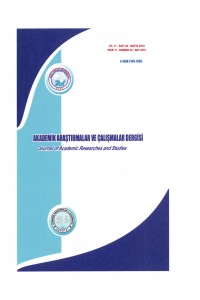Araştırma Makalesi
Yıl 2019,
Cilt: 11 Sayı: 20, 41 - 49, 29.05.2019
Öz
This study
examines the factors determining nominal exchange rate in 77 developing
countries for the period of 2004-2016. Panel data regression model is
constructed in the econometric estimations. According to empirical results,
anti-inflationary policies are necessary to achieve lower nominal exchange rates
in developing countries. Economic growth stemming from higher capital formation
contributes to lower nominal exchange rates as well as implementing economic policies towards
increasing international reserves
Anahtar Kelimeler
Kaynakça
- AGENOR, P.R.,McDERMOTT C.J. and ÜÇER, M. (1997). “Fiscal Imbalances, Capital Flows and the Real Exchange Rate: The Case of Turkey”, IMF Working Paper, No.97/1.ARELLANO, M. (1987). “Computing Robust Standart Errors for within Group Estimators”, Oxford Bulletin of Economics and Statistics, 49(4): 431-434.BALTAGI, B. H., and WU, P. X. (1999). “Unequally Spaced Panel Data Regressions with AR(1) Disturbances”, Econometric Theory, 15: 814-823.BENAZIC, M. and SKABIC-KERSAN, I. (2016). “The Determinants of Exchange Rate in Croatia", Eastern Journal of European Studies, 7(1): 125-150.BHARGAVA, A.,FRANZINI, L. and NARENDRANATHAN, W. (1982). “Serial Correlation and the Fixed Effects Model”, Review of Economic Studies, 49(4): 533-549.BOTTAI, M. (2003). “Confidence Regions when the Fisher Information is Zero”, Biometrika, 90(1): 73-84.BOURAOUIA, T. and PHISUTHTIWATCHARAVONG, A. (2015). “On the Determinants of the THB/USD Exchange Rate”, Procedia Economics and Finance, 30: 137-145BREUSCH, T. S. and PAGAN, A. R. (1980). “The Lagrange Multiplier Test and its Applications to Model Specification in Econometrics”, The Review of EconomicStudies, 47(1): 239-253.CEVHER, E. (2016). “Döviz Kurunun Belirleyicilerinin Koşullu ve Kısmi Granger Nedensellik Testleri ile Araştırılması”, (Ed.) YURDAKUL, F., Döviz Kurunun Belirleyicileri: Kısmi ve Koşullu Granger Nedensellik, SETAR, LSTAR, TVAR Modelleri: 105-160, Ankara: Gazi Kitabevi. ÇEVİŞ, İ. and KADILAR, C. (2001). “The Analysis of the Short-Term Capital Movements by Using the VAR Models: The Case of Turkey”, The Pakistan Development Review, 40(3):187-201.CHIU, M. (2008). “An Empirical Study on the Long-Run Determinants of Exchange Rate”, Review of Pacific Basin Financial Markets and Policies, 11(3): 389-409.DROPSY, V. (1996). “Macroeconomic Determinants of Exchange Rates: A Frequency-Specific Analysis”, AppliedEconomics, 28: 55-63.FROOT, K.A. (1989). “Consistent Covariance Matrix Estimation with Cross Sectional Dependence and Heteroskedasticity in Financial Data”, Journal of Financial and Quantitative Analysis, 24(3): 333-355.GREENE, W. (2000). Econometric Analysis, Upper Saddle River, NJ: Prentice-Hall.HAUSMAN, J. A. (1978). “Specification Tests in Econometrics”, Econometrica, 46(6): 1251-1271.HONDA, Y. (1985). “Testing the Error Components Model with Non-Normal Disturbances”, Review of Economic Studies, 52: 681-690.HSING, Y. (2015a). “Short-Run Determinants of the USD/PLN Exchange Rate and Policy Implications”, Theoretical and Applied Economics, Volume XXII, No. 2(603): 247-254HSING, Y. (2015b). “Short-Run Determinants of the IDR/USD Exchange Rate: A Simultaneous-Equation Model”, Global EconomyJournal, 15(3): 311-318.HSING, Y. (2016). “Determinants of the Hungarian Forint/ US Dollar Exchange Rate”, Theoretical and Applied Economics, Volume XXIII, No. 1(606): 163-170.KANDİL, M. (2015). “On the Benefits of Nominal Appreciations: Contrasting Evidence Across Developed and DevelopingCountries”, Borsa Istanbul Review, 15-4: 223-236.KAYA, Y. T. (1998). Sermaye Hareketleri ve Kısa Vadeli Sermaye Hareketlerinin Modellenmesi: Türkiye Örneği, Ankara: Devlet Planlama Teşkilatı, Yayın No: DPT: 2487.KING, M. L., and WU, P. X. (1997). “Locally Optimal One Sided Tests for Multiparameter Hypotheses”, Econometric Reviews,16: 131-156.KURT, Ü and ÇALIŞKAN, Z.D. (2016). “Türkiye Ekonomisinde Döviz Kurlarının Açıklanmasında Parasal Modelin Geçerliliği: ARDL Modeli Uygulaması”, Journal of Strategic Research in Social Science, 2(4): 29-40. MOULTON, B. R. and RANDOLPH, W. C. (1989). “Alternative Tests of the Error Components Model”, Econometrica, 57(3): 685-693.ROGERS, W.H. (1993). “Regression Standard Errors in Clustered Samples”, Stata Technical Bulletin, 13: 19-23.SEKMEN, F. and RAVANOĞLU, G.A. (2017). “Faiz Haddi ve Para Arzının Döviz Kuru Üzerine Etkisi”, Manas Sosyal Araştırmalar Dergisi, 6(4): 333-342. YURDAKUL, F. (2016). “Döviz Kuru Modellemesi: Türkiye Üzerine Bir Uygulama”, YURDAKUL, F., Döviz Kurunun Belirleyicileri: Kısmi ve Koşullu Granger Nedensellik, SETAR, LSTAR, TVAR Modelleri: 1-49, Ankara: Gazi Kitabevi. WORLD BANK (2017). World Development Indicators, http://databank.worldbank.org/data/reports.aspx?source=world-development-indicators, (10.10.2017)
Toplam 1 adet kaynakça vardır.
Ayrıntılar
| Birincil Dil | İngilizce |
|---|---|
| Konular | Ekonomi |
| Bölüm | ARAŞTIRMA MAKALELERİ |
| Yazarlar | |
| Yayımlanma Tarihi | 29 Mayıs 2019 |
| Yayımlandığı Sayı | Yıl 2019 Cilt: 11 Sayı: 20 |
Kaynak Göster
Bu eser Creative Commons Atıf-GayriTicari 4.0 Uluslararası Lisansı ile lisanslanmıştır.

